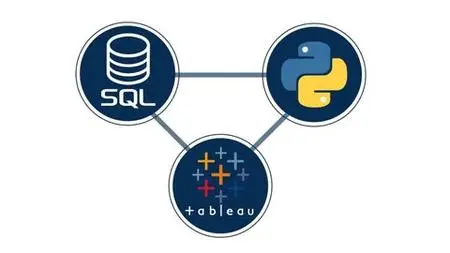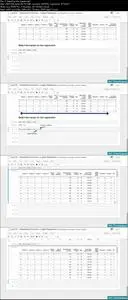Python + SQL + Tableau: Integrating Python, SQL, and Tableau
Video: .mp4 (1280x720, 30 fps(r)) | Audio: aac, 44100 Hz, 2ch | Size: 2.65 GB
Genre: eLearning Video | Duration: 90 lectures (5 hour, 13 mins) | Language: English
Video: .mp4 (1280x720, 30 fps(r)) | Audio: aac, 44100 Hz, 2ch | Size: 2.65 GB
Genre: eLearning Video | Duration: 90 lectures (5 hour, 13 mins) | Language: English
See the full picture: Learn how to combine the three most important tools in data science: Python, SQL, and Tableau.
What you'll learn
How to use Python, SQL, and Tableau together
Software integration
Data preprocessing techniques
Apply machine learning
Create a module for later use of the ML model
Connect Python and SQL to transfer data from Jupyter to Workbench
Visualize data in Tableau
Analysis and interpretation of the exercise outputs in Jupyter and Tableau
Requirements
Basic coding skills in Python
Basic knowledge of SQL
Basic ability to use Tableau for data visualization
Description
Python, SQL, and Tableau are three of the most widely used tools in the world of data science.
Python is the leading programming language;
SQL is the most widely used means for communication with database systems;
Tableau is the preferred solution for data visualization;
To put it simply – SQL helps us store and manipulate the data we are working with, Python allows us to write code and perform calculations, and then Tableau enables beautiful data visualization. A well-thought-out integration stepping on these three pillars could save a business millions of dollars annually in terms of reporting personnel.
Therefore, it goes without saying that employers are looking for Python, SQL, and Tableau when posting Data Scientist and Business Intelligence Analyst job descriptions. Not only that, but they would want to find a candidate who knows how to use these three tools simultaneously. This is how recurring data analysis tasks can be automated.
So, in this course we will to teach you how to integrate Python, SQL, and Tableau. An essential skill that would give you an edge over other candidates. In fact, the best way to differentiate your job resume and get called for interviews is to acquire relevant skills other candidates lack. And because, we have prepared a topic that hasn’t been addressed elsewhere, you will be picking up a skill that truly has the potential to differentiate your profile.
Many people know how to write some code in Python.
Others use SQL and Tableau to a certain extent.
Very few, however, are able to see the full picture and integrate Python, SQL, and Tableau providing a holistic solution. In the near future, most businesses will automate their reporting and business analysis tasks by implementing the techniques you will see in this course. It would be invaluable for your future career at a corporation or as a consultant, if you end up being the person automating such tasks.
Our experience in one of the large global companies showed us that a consultant with these skills could charge a four-figure amount per hour. And the company was happy to pay that money because the end-product led to significant efficiencies in the long run.
The course starts off by introducing software integration as a concept. We will discuss some important terms such as servers, clients, requests, and responses. Moreover, you will learn about data connectivity, APIs, and endpoints.
Then, we will continue by introducing the real-life example exercise the course is centered around – the ‘Absenteeism at Work’ dataset. The preprocessing part that follows will give you a taste of how BI and data science look like in real-life on the job situations. This is extremely important because a significant amount of a data scientist’s work consists in preprocessing, but many learning materials omit that
Then we would continue by applying some Machine Learning on our data. You will learn how to explore the problem at hand from a machine learning perspective, how to create targets, what kind of statistical preprocessing is necessary for this part of the exercise, how to train a Machine Learning model, and how to test it. A truly comprehensive ML exercise.
Connecting Python and SQL is not immediate. We have shown how that’s done in an entire section of the course. By the end of that section, you will be able to transfer data from Jupyter to Workbench.
And finally, as promised, Tableau will allow us to visualize the data we have been working with. We will prepare several insightful charts and will interpret the results together.
As you can see, this is a truly comprehensive data science exercise. There is no need to think twice. If you take this course now, you will acquire invaluable skills that will help you stand out from the rest of the candidates competing for a job.
Also, we are happy to offer a 30-day unconditional no-questions-asked-money-back-in-full guarantee that you will enjoy the course.
So, let’s do this! The only regret you will have is that you didn’t find this course sooner!
Who this course is for:
Intermediate and advanced students
Students eager to differentiate their resume
Individuals interested in a career in Business Intelligence and Data Science





